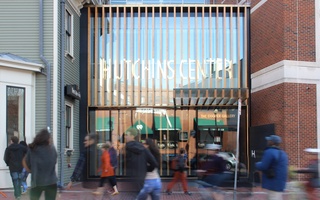This gallery also functions in tandem with the Art Study Center, a space on the Museums’ fourth floor that offers students the chance to engage with works of art firsthand. Students can request to view works in person in natural light, without glass in between them and the art, according to the Museums’ deputy director, Maureen I. Donovan, who led a tour of the new facilities at the press opening.
The Art Study Center seems to take everything a student might need into account. Before interacting with the art, students can stash away their backpacks in individual lockers with built-in locks. Researchers can convene without disturbing others and take breaks from their work in a hallway off the center.
{shortcode-0260fc8ffd25d9be0a1694e3a8e37996fe351a3a}
The second undergraduate-based gallery, the University Teaching Gallery, is devoted to History of Art and Architecture classes. Three HAA classes will use this gallery in the spring: Suzanne P. Blier’s HAA 194w: “Worlds Fairs,” Yukio Lippit’s HAA 18p: “The Japanese Woodblock Print,” and Melissa M. McCormick’s HAA 18k: “Introduction to Japanese Art.”
Blier said she hopes her exhibition will help students see the importance of viewing images in person, rather than on a screen, which she said often misrepresents artistic features including scale, three-dimensionality, and texture.
“[The University Teaching Gallery] will be really important in having students begin to look really closely at works of art and works of visual culture more generally,” Blier said. “You’re able to look closely at these images and in essence discover the world anew.”
For now, HAA professors will curate installations for their classes in the gallery, but in the future, students may have a chance to test their hands at selecting which pieces go on display, Martinez said.
The Museums’ other facilities were also built with teaching students in mind. In the Materials Lab, on the lower level of the building, visiting artists and conservators will lead workshops with students to demonstrate how the galleries’ various works were created, according to Kao.
“[It’s] the place for exploring materials that art is made with—so just a different kind of classroom,” Donovan said.
BEYOND THE CLASSROOM
For students who take the initiative to participate behind the scenes, administrators hope that the Harvard Art Museums can go even further as teaching tools.
Through their participation in an advisory board, convened last spring, 19 students have already played a part in rolling out events at the renovated Museums. These board members, 15 undergraduates and four graduate students, were instrumental in planning the student opening event earlier this month. Now that the building has opened its doors, Martinez and the advisory board still want to keep students in mind.
“The question really is: how do we include students in the thinking and the development of this project?” Martinez asked. “How might they push our thinking? And how might they—in every way—give us different access?”
Beyond the students who sit on the existing advisory board, another group of 18 students will serve as liaisons between the Museums and greater Cambridge through leading tours of the collections. In this way, there is a role reversal: Administrators hope that these students can act as teachers to advance the educational mission of the Museums, rather than just receive it.
These students, called student guides, will lead the public tours starting in February. The guides are now trying their hands at curating as they brainstorm how best to engage visitors.
Read more in News
Panel Focuses on Rise in Boston's Urban AgricultureRecommended Articles
-
Community BRIEFSBus Breaks Down Returning From U.C. Sponsored Ski Trip A bus carrying 49 students returning from yesterday's Undergraduate Council-sponsored ski
-
Students Rarely Frequent MuseumsIn a glossy brochure given to all members of the Class of 1998, President Neil L. Rudenstine puts in a
-
ART MUSEUMS HOLD MEETING AT FOGGFifteen art museums throughout the country, including Boston's famous Gardner Museum, and Museum, of Fine Arts, and the Metropolitan Museum
-
 At Crossroads: The Ethelbert Cooper Gallery
At Crossroads: The Ethelbert Cooper Gallery -
 Gathering the Galleries
Gathering the Galleries













